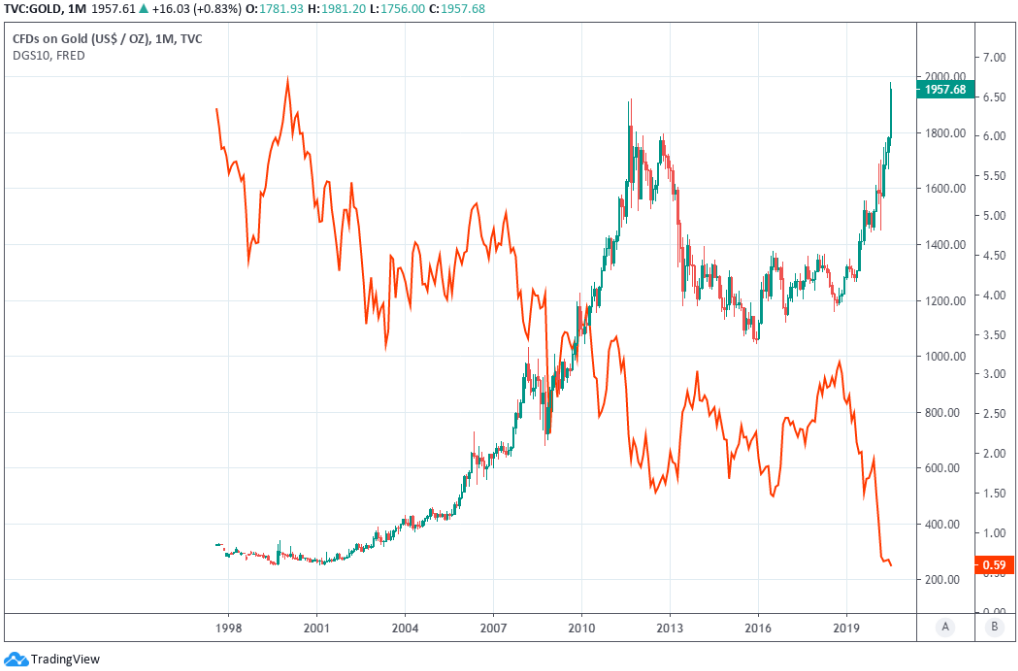Gold Price Needs U.S. Economy to Fend Off 'Deflation' for New Record Highs to Keep Rolling In
- Written by: James Skinner
-

Image © Adobe Stock
Gold futures prices have clocked up repeated new record highs of late amid a downturn in the Dollar and and uncertainty about the global recovery, although the rally needs the U.S. economy to fend off the spectre of 'deflation' more than anything else if it's to endure and new highs are to keep coming in.
Investors have piled into gold this year and especially since May although gains stepped up this last week as the yellow metal rose more than 7% to leave it sat on a 10% increase for July and 28.5% gain for the 2020 year-to-date.
"Gold prices have recovered from their drop overnight, with the pullback towards $1900 offering the first real entry for new longs in over a week. With so much attention focused on the metal there will be plenty of traders looking to hop on the summer’s latest exciting move. Gold and US equities are both beneficiaries of the weaker dollar, so while it might seem odd to see both doing well it is not necessarily a reason for caution," says Chris Beauchamp, chief analyst at IG.
July's rally higher has coincided with a big leg lower in the value of the Dollar relative to other major currencies and strong gains for the stock markets, although it's also come concurrent with an escalation of the coronavirus outbreak in the world's largest economy where daily infection numbers have also set repeated new records.
Above: Gold price at monthly intervals with 10-year U.S. bond yield (orange line).
Secure a retail exchange rate that is between 3-5% stronger than offered by leading banks, learn more.
The gold outlook turned for the better when the coronavirus closed down European and North American economies, prompting unprecedented government action and a reinvention of central banks' crisis-fighting toolboxes.
The market result has been new lows for bond yields and vast increases in the supply of major fiat currencies.
Nowhere else has this been more observable than in the U.S. where the Federal Reserve has launched an unlimited quantitative easing programme, creating new money to buy up not only federal and local government bonds but also coprorate debt including that which is rated below 'investment grade.'
"The yellow metal has a propensity to rise when real interest rates decline as it reduces the opportunity cost of holding it. At yesterday’s close, the yield on 10-year TIPS was at -0.90%, essentially matching the record low observed in December 2012. Is there a risk for a sharp reversal in real rates in the coming months as we’ve seen in 2013? We don’t think so," says Matthieu Arseneau, deputy chief economist at National Bank of Canada Financial Markets.
Increased government spending, coming amid the unprecedented needs of the economy, has seen the Fed's balance sheet rise from $4.2 trillion to more than $7 trillion in early June even as bond yields plumbed new lows amid increased demand from the lender of last resort. This has weighed on the Dollar and seen 'real yields,' - coupon payments expressed as a percentage return but adjusted for inflation - return to earlier historic lows.
Above: 10-year U.S. Treasury Inflation Protected Security yield (blue line) with gold price.
Secure a retail exchange rate that is between 3-5% stronger than offered by leading banks, learn more.
"Our model estimates that no less than $253 dollars of the $421 increase can be attributed to the massive drop in real rates," Arseneau says. "With Congress set to unleash yet another round of fiscal stimulus to be financed by the Federal Reserve, we expect negative real interest rates to endure for the foreseeable future. Bullion has limited downside in such an environment."
Policymakers the world over are all singing from the same hymn sheet but its actions of the world's pre-eminent central bank have driven up the gold price, which is negatively correlated with both the falling U.S. Dollar and bond yields once they've been adjusted for inflation.
But yields could remain depressed for a considerable period, according to Arseneau, who cites the post-war years as instructive of the likely outlook for bonds. The debilitating cost of the conflict saw real yields kept negative for a protracted period, leading vast debts to begin to be inflated away.
"The Fed, who start a two-day meeting today, are obviously going to be at zero and expanding their balance sheet for years to either keep people in work, bring back jobs, build a better army, or a better society, or world. Yet that does not necessarily mean the Fed are going to succeed in hitting the one target they were supposed to be focused on in the market’s mind - inflation. Japan shows even a 100%+ central-bank balance sheet is no guarantee of any inflation at all,” says Michael Every, a global strategist at Rabobank. "If the US were to slip into deflation, meaning positive real rates again unless the Fed goes negative, how will yield-free, no-end-use gold look?"
Every and Arseneau both say gold is heavily influenced by real interest rates, which means the outlook for them should be interwined with that of the U.S. economy seeing as inflation is a function of growth, among other things.
Above: Trade weighted Dollar Index (red) with 10-year U.S. Treasury Inflation Protected Security yield (blue line).
There's less agreement on the outlook for gold, however, as Rabobank is wary that inflation could turn negative in the near future and lift those all-important 'real yields.' This would amount to a disincentive for holding the precious metal, albeit an imperfect one. Negative price changes would eventually be followed by a return of inflation that would again weigh on real yields and could lift precious metals unless consumer price pressures are addressed through higher benchmark interest rates at the Fed.
"You can buy gold because others are buying gold. Yet you can’t buy gold with the expectation that it is ever going to be anything other than something heavy you need to schlep," Every says.
The Fed said in June it would continue crushing yields for an unspecified period of time and has more or less ruled out rate hikes until it's on course to meet its "its maximum employment objective". This ties the fortune of gold to that of the U.S. economy and likely sets in stone a bumpy path for gold prices as the precious metal and bond markets navigate the troughs and peaks of inflation throughout the economic and labour market recoveries.
The U.S. economy contracted by -5% in the first quarter, far more than in many other major economies, and on Thursday Bureau of Economic Analysis data is expected to reveal a -35% annualised contraction.
By many estimates the U.S. collapse likely dwarfed anything else seen by others in the second quarter. Meanwhile, inflation rose by 0.6% on an annualised basis after having risen by just 0.1% in May, and five-year inflation expectations have continued to rise from March lows.
Above: U.S. inflation for all items expressed as annualised percentage. Source: Bureau of Labor Statistics.

